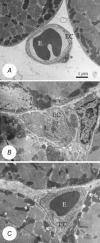Attenuation of changes in capillary fine structure and leukocyte adhesion improves muscle performance following chronic ischaemia in rats
- PMID: 18755748
- PMCID: PMC2614055
- DOI: 10.1113/jphysiol.2008.158055
Attenuation of changes in capillary fine structure and leukocyte adhesion improves muscle performance following chronic ischaemia in rats
Abstract
Acute ischaemia-reperfusion disrupts capillary fine structure and increases leukocyte adhesion in postcapillary venules. We determined whether chronic muscle ischaemia has similar consequences, and whether it is possible to ameliorate its effect on muscle performance. Following ischaemia (unilateral ligation, common iliac artery) rat hindlimb muscles were examined without other intervention or following treatment with an xanthine oxidase inhibitor (allopurinol), a Na(+)/H(+) exchange blocker (amiloride), or an oxygen free radical scavenger (vitamin E). No significant leukocyte adhesion or rolling, nor changes in capillary fine structure were observed 3 days postsurgery, when limb use was limited. However, leukocyte rolling and adhesion almost trebled by 7 days (P < 0.001), when normal gait was largely restored. Capillary fine structure was disturbed over a similar time course, e.g. relative endothelial volume (control 46%, 7 days 61%; P < 0.05), that resolved by 5 weeks. Where activity was increased by mild electrical stimulation 3 days after ligation muscles showed enhanced capillary swelling (endothelial volume 66% versus 50%, P < 0.005), but improved fatigue index (52% versus 16%, P < 0.001) as a result of greater blood flow. Muscle fatigue after ligation was related to the extent of contraction-induced hyperaemia (R(2) = 0.725), but not capillary swelling. Amiloride, and to a lesser extent allopurinol but not vitamin E, significantly decreased leukocyte rolling and adhesion, as well as capillary endothelial swelling. We conclude that increased activity of ischaemic muscles on recovery is likely to accentuate acidosis accompanying changes in microcirculation and contribute to enhanced muscle fatigue, whereas formation of oxygen free radicals may be attenuated by endogenous protective mechanisms.
Figures







Similar articles
-
ICAM-1 expression and leukocyte behavior in the microcirculation of chronically ischemic rat skeletal muscles.Microvasc Res. 2006 May;71(3):205-11. doi: 10.1016/j.mvr.2006.03.003. Epub 2006 May 2. Microvasc Res. 2006. PMID: 16647725
-
Spatial and temporal correlation between leukocyte behavior and cell injury in postischemic rat skeletal muscle microcirculation.Lab Invest. 1994 May;70(5):684-95. Lab Invest. 1994. PMID: 7910874
-
The effect of alpha 1 adrenoceptor antagonist prazosin on capillary supply, blood flow and performance in a rat model of chronic muscle ischaemia.Eur J Vasc Endovasc Surg. 1998 Jul;16(1):71-7. doi: 10.1016/s1078-5884(98)80095-6. Eur J Vasc Endovasc Surg. 1998. PMID: 9715720
-
[In vivo evaluation of leukocyte dynamics in the retinal and choroidal circulation].Nippon Ganka Gakkai Zasshi. 1999 Dec;103(12):910-22. Nippon Ganka Gakkai Zasshi. 1999. PMID: 10643293 Review. Japanese.
-
Inflammatory responses to ischemia and reperfusion in skeletal muscle.Mol Cell Biochem. 1998 Feb;179(1-2):169-87. doi: 10.1023/a:1006832207864. Mol Cell Biochem. 1998. PMID: 9543359 Review.
Cited by
-
Structural Microangiopathies in Skeletal Muscle Related to Systemic Vascular Pathologies in Humans.Front Physiol. 2020 Feb 5;11:28. doi: 10.3389/fphys.2020.00028. eCollection 2020. Front Physiol. 2020. PMID: 32116748 Free PMC article.
-
Exercise training and peripheral arterial disease.Compr Physiol. 2012 Oct;2(4):2933-3017. doi: 10.1002/cphy.c110065. Compr Physiol. 2012. PMID: 23720270 Free PMC article. Review.
-
Skeletal Muscle Microvascular Changes in Response to Short-Term Blood Flow Restricted Training-Exercise-Induced Adaptations and Signs of Perivascular Stress.Front Physiol. 2020 Jun 12;11:556. doi: 10.3389/fphys.2020.00556. eCollection 2020. Front Physiol. 2020. PMID: 32595516 Free PMC article.
-
Impaired skeletal muscle performance as a consequence of random functional capillary rarefaction can be restored with overload-dependent angiogenesis.J Physiol. 2020 Mar;598(6):1187-1203. doi: 10.1113/JP278975. Epub 2020 Feb 26. J Physiol. 2020. PMID: 32012275 Free PMC article.
References
-
- Akimitsu T, Gute DC, Korthuis RJ. Leukocyte adhesion induced by inhibition of nitric oxide production in skeletal muscle. J Appl Physiol. 1995;78:1725–1732. - PubMed
-
- Anderson SI, Hudlická O, Brown MD. Capillary red blood cell flow and activation of white blood cells in chronic muscle ischemia. Am J Physiol Heart Circ Physiol. 1997;272:H2757–H2764. - PubMed
-
- Anderson SI, Shiner R, Brown MD, Hudlická O. ICAM-1 expression and leukocyte behaviour in the microcirculation of chronically ischemic rat skeletal muscle. Microvascular Res. 2006;75:205–211. - PubMed
-
- Ando J, Tsuboi H, Korenaga R, Takeda Y, Toyamasorimachi N, Miasaka M, Kamiya A. Shear stress inhibits adhesion of cultured mouse endothelial cells to lymphocytes by down-regulating VCAM-1 expression. Am J Physiol Cell Physiol. 1994;267:C679–C687. - PubMed
-
- Angersbach D, Jukna JJ, Nicholson CD, Ochlich P, Wilke R. The effect of short-term and long-term femoral artery ligation on rat calf muscle oxygen tension, blood flow, metabolism and function. J Microcirc Clin Exp. 1988;7:15–30. - PubMed
Publication types
MeSH terms
LinkOut - more resources
Full Text Sources
Medical

